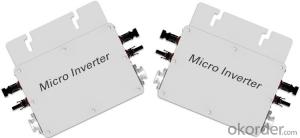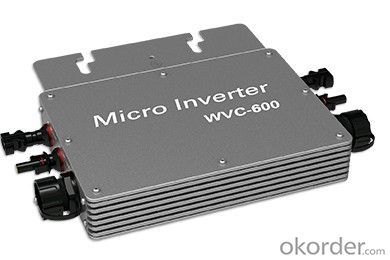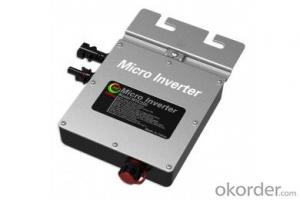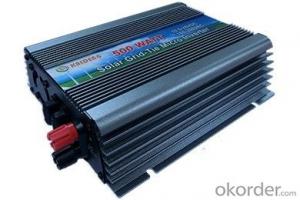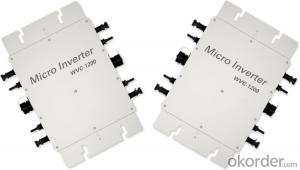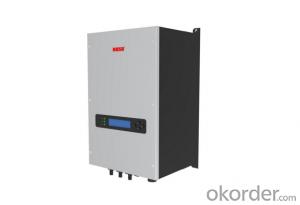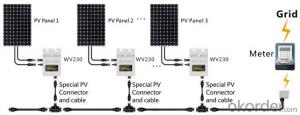1KW Solar Inverter Price - KD-WVC600 Series Micro Inverter, Hot Sales
- Loading Port:
- China main port
- Payment Terms:
- TT OR LC
- Min Order Qty:
- 1000 pc
- Supply Capability:
- 100000 pc/month
OKorder Service Pledge
OKorder Financial Service
You Might Also Like
Structure
The transition from a centralized to a distributed inverter optimizes energy collection.
The converter module integrated into the solar panels can reduce installation costs.
Soft switch technology to replace hard-switching technology can improve efficiency and reduce heat dissipation.
From cottage industry to mass production, standardized design (hardware and software) to improve reliability and reduce costs.
Using a special capacitor (due to the high failure rate). Design requires a higher voltage to reduce the current, we use a special electrolytic capacitors.
The converter can be connected to the grid to eliminate the need for many battery applications. The high price of batteries, require maintenance, life expectancy is shorter.
Work required micro-inverter power increasingly smaller (only a few hundred watts), which can reduce the internal temperature and improve reliability.
Micro-inverter solar inverter system needs to deal with a lot of a particular power level, in order to increase production, thereby reducing costs.
DC input voltage range:
22-50VDCAC
output voltage range:80-160VAC/180-260V
ACAC output power :600Wp
AC frequency range:50Hz/60Hz
G.W.:2.85kg
Size:289mm*200mm*38mm
KD-WVC295 Series Using IP67 waterproof streamline design, Can effectively prevent rainwater on the surface erosion, Built-in high-performance Maximum Power Point Tracking(MPPT)Function,Better able to track changes in the solar luminosity and control different output power, Effectively capture and collect sunlight. AC electric power transmission using the reverse transmission technology, Is one of our patented technology, The inverter output power can provide load priority use, Extra electricity to the grid, Efficient use of the inverter to the power emitted, Electricity transmission rate of up to 99%.
Features
Pure Sine Wave Output;
High performance Maximum Power Point Tracking(MPPT);
Power Automatically Locked(APL);
Reverse power transmission;
High-Frequency High Conversion Rate;
Anti-Islanding Protect;
Input /output is fully isolated to protect the electrical safety;
Multiple parallel stacking;
The Leading Patent Technology;
IP65 WaterProof;
Flexible Installation;
Simplify maintenance (user serviceable)
High Efficiency & Best Cost-Effectiveness
Using a special capacitor (due to the high failure rate). Design requires a higher voltage to reduce the current, we use a special electrolytic capacitors.
The converter can be connected to the grid to eliminate the need for many battery applications. The high price of batteries, require maintenance, life expectancy is shorter.
Work required micro-inverter power increasingly smaller (only a few hundred watts), which can reduce the internal temperature and improve reliability.
Images
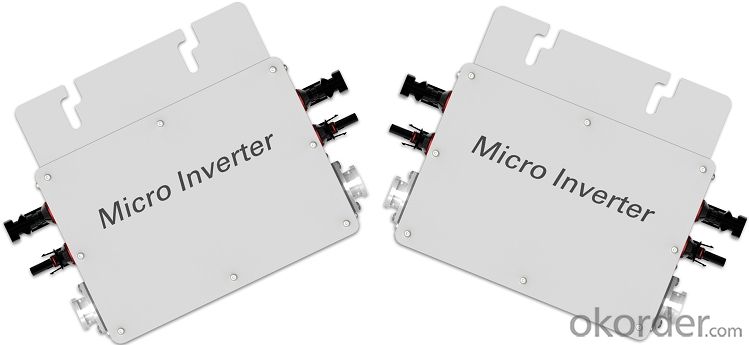

Specification
Input Data | KD-WV250-120VAC/230VAC | |||
Recommended input power | 200-300Watt | |||
Recommend the use of PV modules | 300W/Vmp>34V/Voc<50v< span=""> | |||
Maximum input DC voltage | 50V | |||
Peak power tracking voltage | 25-40V | |||
Operating Voltage Range | 17-50V | |||
Min / Max start voltage | 22-50V | |||
Maximum DC short current | 15A | |||
Maximum Input Current | 9.8A | |||
Output Data | @120VAC | @230VAC | ||
Peak power output | 260Watt | 260Watt | ||
Rated output power | 250Watt | 250Watt | ||
Rated output current | 2.08A | 0.92A | ||
Rated voltage range | 80-160VAC | 180-260VAC | ||
Rated frequency range | 57-62.5Hz | 47-52.5Hz | ||
Power factor | >96% | >96% | ||
Maximum units per branch circuit | 15PCS(Single-phase) | 30PCS(Single-phase) | ||
Output Efficiency | @120VAC | @230VAC | ||
Static MPPT efficiency | 99.5% | 99.5% | ||
Maximum output efficiency | 92.3% | 94.6% | ||
The average efficiency | 91.2% | 93.1% | ||
Night time power consumption | <50mW Max | <70mW Max | ||
THDI | <5%< span=""> | <5%< span=""> | ||
Exterior | ||||
Ambient temperature | -40°C to +60°C | |||
Operating temperature range (inverter inside) | -40°C to +82°C | |||
Dimensions (WxHxD) | 191mm*1176mm*38mm | |||
Weight | 0.83kg | |||
Waterproof Rating | IP65 | |||
Cooling | Self-cooling | |||
Feature | ||||
Power transmission mode | Reverse transfer, load priority | |||
Electromagnetic compatibility | EN50081.part1EN50082.part1 | |||
Grid disturbance | EN61000-3-2 Safety EN62109 | |||
Grid detection | DIN VDE 1026 UL1741 | |||
Certificate | CEC,CE National patent technology | |||
FAQ
Can we visit your factory?
Surely, I will arrange the trip basing on your business schedule.
Can you do OEM for us?
Yes, we can.
How do you pack your products?
We have rich experience on how to pack the panels to make sure the safety on shipment when it arrives at the destination.
Can you help us install the module if we cooperate with you?
We haven’t entered into installation sector, but we have the plan in near future.
- Q: How do you calculate the efficiency loss due to temperature for a solar inverter?
- To calculate the efficiency loss due to temperature for a solar inverter, you would typically refer to the manufacturer's specifications and documentation. The efficiency loss can be determined by comparing the inverter's rated efficiency at a specific temperature (usually 25 degrees Celsius) to its efficiency at the desired operating temperature. The manufacturer may provide a temperature coefficient, which represents the percentage decrease in efficiency for every degree increase in temperature. By multiplying the temperature coefficient with the difference between the desired operating temperature and the reference temperature, you can estimate the efficiency loss due to temperature.
- Q: Are there any noise or sound considerations with a solar inverter?
- Yes, there are noise considerations with a solar inverter. While solar inverters typically produce low levels of noise, it is important to ensure that the inverter is placed in a well-ventilated area to avoid any potential fan or cooling system noise. Additionally, some older models of inverters may produce a slight humming sound during operation, although newer models have significantly reduced this noise.
- Q: How does the harmonic distortion affect the performance of a solar inverter?
- Harmonic distortion can have a negative impact on the performance of a solar inverter. It can lead to increased heat generation, reduced efficiency, and can even cause damage to the inverter components. Additionally, harmonic distortion can introduce electrical noise into the system, which can affect the quality of the output waveform and potentially interfere with other connected devices. Therefore, minimizing harmonic distortion is important to ensure optimal performance and reliable operation of a solar inverter.
- Q: What is the role of a grid connection feature in a solar inverter?
- The role of a grid connection feature in a solar inverter is to allow the solar power system to connect and interact with the electrical grid. This feature enables the solar inverter to convert the direct current (DC) produced by the solar panels into alternating current (AC) that is compatible with the electrical grid. It ensures that excess solar energy can be fed back into the grid, allowing the system owner to receive credit or payments for the electricity generated. Additionally, the grid connection feature allows the system to draw power from the grid when solar energy is insufficient, ensuring a reliable and continuous power supply.
- Q: What are the installation requirements for a solar inverter?
- The installation requirements for a solar inverter typically include a suitable mounting location, proper ventilation, and a stable electrical connection. The inverter should be installed in a shaded area, away from direct sunlight and extreme temperatures. It should be mounted securely on a sturdy surface, such as a wall or a rack. Adequate ventilation is necessary to dissipate heat generated during operation. Additionally, the inverter must be connected to the electrical panel or grid with the appropriate wiring and circuit breakers, following local electrical codes and regulations.
- Q: How does a solar inverter handle voltage fluctuations from the solar panels?
- A solar inverter handles voltage fluctuations from the solar panels by continuously monitoring the output voltage and adjusting it to maintain a stable and consistent level of voltage. It employs advanced control algorithms and power electronics to regulate and stabilize the voltage, ensuring optimal energy conversion and compatibility with the electrical grid. This helps protect the inverter and other connected devices from damage while maximizing the energy output from the solar panels.
- Q: How does a solar inverter prevent islanding?
- A solar inverter prevents islanding by constantly monitoring the electrical grid's voltage and frequency. If it detects a disruption or deviation from the standard parameters, it immediately shuts down or disconnects from the grid to prevent energy from being fed back into the grid during a power outage. This ensures the safety of utility workers who might be working on the grid and prevents any damage to the electrical system.
- Q: What is the lifespan of the warranty on a solar inverter?
- The lifespan of a warranty on a solar inverter can vary depending on the manufacturer and the specific model. However, most warranties typically range from 5 to 10 years, with some higher-end inverters offering warranties up to 25 years. It is important to carefully review the warranty terms and conditions provided by the manufacturer to understand the coverage and duration of the warranty.
- Q: Can a solar inverter be used in a mobile or portable solar system?
- Yes, a solar inverter can be used in a mobile or portable solar system. In fact, it is a crucial component that converts the direct current (DC) generated by the solar panels into alternating current (AC) that can be used to power various devices and appliances. Portable solar systems often include a built-in inverter, allowing them to provide convenient and clean energy on the go.
- Q: Can a solar inverter be used for both grid-tied and off-grid systems?
- Yes, a solar inverter can be used for both grid-tied and off-grid systems. However, it is important to note that different types of inverters are designed specifically for each system. Grid-tied inverters are used to convert the DC power generated by solar panels into AC power to feed into the grid, while off-grid inverters are designed to convert DC power from solar panels into AC power for use in standalone systems. So, while the same physical inverter may not be suitable for both applications, there are inverters available for each system type.
Send your message to us
1KW Solar Inverter Price - KD-WVC600 Series Micro Inverter, Hot Sales
- Loading Port:
- China main port
- Payment Terms:
- TT OR LC
- Min Order Qty:
- 1000 pc
- Supply Capability:
- 100000 pc/month
OKorder Service Pledge
OKorder Financial Service
Similar products
Hot products
Hot Searches
Related keywords
